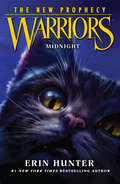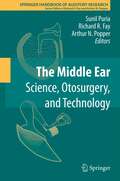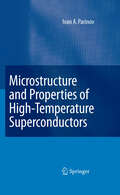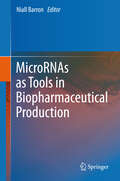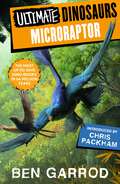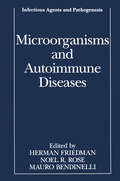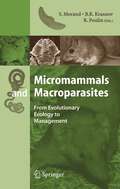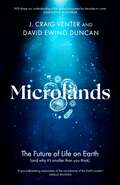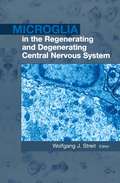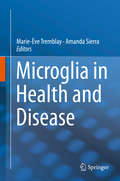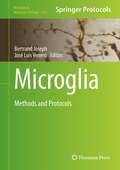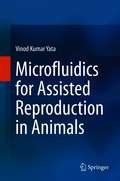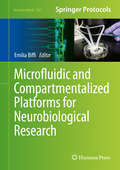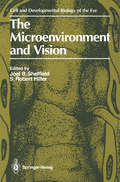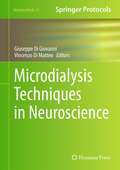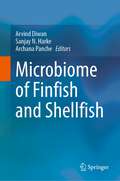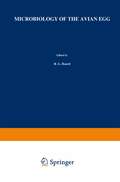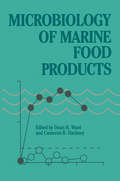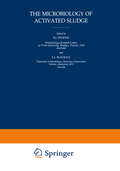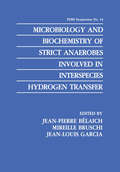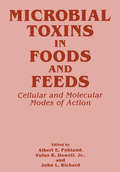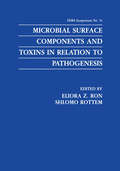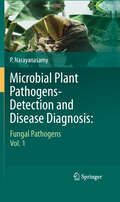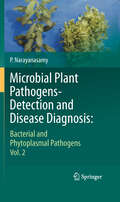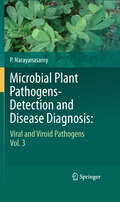- Table View
- List View
MIDNIGHT (Warriors: The New Prophecy #1)
by Erin HunterIn the exciting second Warriors story arc, the wild cats of the forest have lived in peace and harmony for many moons – but new prophecies from their warrior ancestors speak of a mysterious destiny and grave danger for the clans. Now the time has come for a new generation of heroes to arise, as the quest to save the warrior cats begins…
The Middle Ear: Science, Otosurgery, and Technology (Springer Handbook of Auditory Research #46)
by Sunil Puria, Richard R. Fay and Arthur N. PopperThe middle ear plays a vital role in the sense and sensitivity of hearing. Of the various characteristics that distinguish mammals from other vertebrates, several pertain specifically to the middle-ear system, such as the presence of three middle-ear bones and the four-layer composite structure of the tympanic membrane. The Middle Ear attempts to elucidate the role this system plays in sound transmission, as viewed from both scientific and clinical perspectives.
Microstructure and Properties of High-Temperature Superconductors
by I. A. ParinovThis book provides a comprehensive presentation of all types of HTSC and includes a broad overview on HTSC computer simulations and modeling. Especial attention is devoted to the Bi-Sr-Ca-Cu-O and Y-Ba-Cu-O families that today are the most perspective for applications. The book includes a great number of illustrations and references. The monograph is addressed to students, post-graduate students and specialists, taking part in the development, preparation and researching of new materials.
MicroRNAs as Tools in Biopharmaceutical Production
by Niall BarronFocused manuscript on the potential use/role of miRNAs in bioprocessing, specifically the production of complex proteins in mammalian cells. With that in mind I propose a draft list of topics/chapters along the following lines: Intro on CHO/bioprocessing/engineering challenges to set scene, Genomic organization, biogenesis and mode of action, Identifying miRNA targets: Computational prediction, transcriptomics, proteomices, UTR analysis, etc., miRNA expression in Chinese Hamster Ovary cells, miRNAs as engineering targets: pathway manipulation to impact bioprocess phenotypes, miRNAs as biomarkers, Detection methods: Northern, PCR, hybridization arrays, Next Gen Seq, Manipulation of expression in cultured cells: Transient/stable disregulation, Knockout.
Microraptor (Ultimate Dinosaurs)
by Ben GarrodWhen hunters become the hunted, they need to adapt or die. To survive, Microraptor took to the skies and became a flying dinosaur, but what happened next? You can find out. Brimming with facts and fun, quizzes and Ask the Expert sections, there are 7 more dinosaur's stories to be told in the Ultimate Dinosaur series.Pop a dinosaur in your pocket! Introductions from Chris Packham, Steve Backshall and Dr Jane Goodall. These are the most up-to-date dino books in 66 million years, also available in audio download!TV scientist, Professor Ben Garrod, is proud to be a geek as he mixes top level science and humour to prove that science is for everyone. Looking at the evolutionary arms race, prey, predators, place, time, groups and species, Ben reveals new-look dinosaurs. Additional sections include: Ask an Expert, New Science and Fossil Finder as well as quizzes to test your dinosaur knowledge.'A celebration of everything that science is really about.' NatSCA'A perfect primer for kids to learn more about the amazing "terrible lizards".' BBC Wildlife Magazine'He's the man! The genius is his knowledge; the genius is the man himself!' Chris Evans, Virgin Radio Breakfast Show'Shines a fresh, contemporary light on this ever-popular topic.' The Bookseller'Collectable and eye-catching, with plenty of diagrams and illustrations.' Books for Keeps
Microorganisms and Autoimmune Diseases (Infectious Agents and Pathogenesis)
by Herman Friedman Noel R. Rose Mauro BendinelliExperts in microbiology and autoimmunity examine the association between microorganisms and the development of specific categories of autoimmune diseases. The opening chapters explore the bacterial induction of diseases considered autoimmune in nature. Subsequent chapters describe the role of viruses in the induction of these diseases and of diseases with an autoimmune component. Specific topics include: the role of streptococcal infection in rheumatic fever and the role of Klebsiella in the development of ankylosing spondylitis.
Micromammals and Macroparasites: From Evolutionary Ecology to Management
by S. Morand B. R. Krasnov R. PoulinThis book provides a comprehensive survey of the diversity and biology of metazoan parasites affecting small mammals, of their impact on host individuals and populations, and of the management implications of these parasites for conservation biology and human welfare. Designed for a broad, multidisciplinary audience, the book is an essential resource for researchers, students, and practitioners alike.
Microlands: The Future of Life on Earth (and Why It’s Smaller Than You Think)
by J. Craig Venter David Ewing Duncan'An epic travelogue, brimming with the excitement of discovery. With characteristic panache, Venter unveils the teeming array of bacteria, viruses, and eukaryotes that crowd our planet's oceans' - Siddhartha Mukherjee'This page-turner gives . . . the thrill of seeing our planet's largest universe through the brilliant, intrepid eyes of the scientist who has done more than anyone to unlock the secrets of life' - Martine Rothblatt'A tour de force . . . Venter has expanded biology's horizons. This book explores microbial life on a global scale, providing cutting-edge solutions to problems of environmental change' - Aristides Patrinos'A ripping tale . . . to revolutionize our understanding of our bodies, the oceans, and the planet' - Jack Gilbert'An exhilarating account of how creative science is accomplished' - Sir Richard J. Roberts'[A] fascinating tour of Planet Microbe' - Bill McKibben'Venter and Duncan expand our scope of what it means to be alive' - Jamie Metzl'Inspiring ... change[s] our ideas of how biology is done' - TelegraphUpon completing his historic work on the Human Genome Project in 2002, J. Craig Venter declared that he would sequence the genetic code of all life on earth. Thus began a fifteen-year quest to collect DNA from the world's oldest and most abundant form of life: microbes. Boarding the Sorcerer II, a 100-foot sailboat turned research vessel, Venter travelled over 65,000 miles around the globe to sample ocean water and the microscopic life within.In this book, Venter and science writer David Ewing Duncan tell the remarkable story of these expeditions and of the momentous discoveries that ensued-of plant-like bacteria that get their energy from the sun, proteins that metabolize vast amounts of hydrogen, and microbes whose genes shield them from ultraviolet light. The result was a massive library of millions of unknown genes, thousands of unseen protein families, and new lineages of bacteria that revealed the unimaginable complexity of life on earth. Yet despite this exquisite diversity, Venter encountered sobering reminders of how human activity is disturbing the delicate microbial ecosystem that nurtures life on earth. In the face of unprecedented climate change, Venter and Duncan show how we can harness the microbial genome to develop alternative sources of energy, food, and medicine that might ultimately avert our destruction.A captivating story of exploration and discovery, this book restores microbes to their rightful place as crucial partners in our evolutionary past and guides to our future.
Microglia in the Regenerating and Degenerating Central Nervous System
by Wolfgang J. StreitThe study of microglial cells has recently gained importance for those researching degeneration and regeneration. Microglia in the regenerating and degenerating CNS supports the assertion that understanding microglial biology could perhaps be pivotal for unraveling the pathogenetic mechanisms that underlie Alzheimer's disease, In addition, microglia are also critical for understanding the sequelae of traumatic brain and spinal cord injury, and for the important post-traumatic repair processes. This book gives an up to date account of the role of microglia in degeneration and regeneration of the nervous system and reviews their cell function and physiology.
Microglia in Health and Disease
by Marie-Ève Tremblay Amanda SierraThese past few years have witnessed a revolution in our understanding of microglia, especially since their roles in the healthy central nervous system (CNS) have started to unravel. These cells were shown to actively maintain health, in concert with neurons and other types of CNS cells, providing further insight into their involvement with diseases. Edited by two pioneers in the field, Marie-Ève Tremblay and Amanda Sierra, Microglia in health and disease aims to share with the broader scientific community some of the recent discoveries in microglia research, from a broad perspective, with a collection of 19 chapters from 52 specialists working in 11 countries across 5 continents.To set microglia on the stage, the book begins by explaining briefly who they are, what they do in the healthy and diseased CNS, and how they can be studied. The first section describes in more details their physiological roles in the maturation, function, and plasticity of the CNS, across development, adolescence, adulthood, neuropathic pain, addiction, and aging. The second section focuses on their implication in pathological conditions impairing the quality of life: neurodevelopmental and neuropsychiatric disorders, AIDS, and multiple sclerosis; and in leading causes of death: ischemia and stroke, neurodegenerative diseases, as well as trauma and injury.
Microglia: Methods and Protocols (Methods in Molecular Biology #1041)
by Bertrand Joseph and José Luis VeneroKey discoveries concerning the different biological functions of microglia in health and disease have attracted scientists from various fields. In Microglia: Methods and Protocols, expert researchers in the field detail methods for selection of the key cellular, molecular and biochemical techniques that are used in studying the many and varied functions of this fascinating cell. These methods and techniques include microglia cell culture for studying microglia activation and functions, as well as their interaction with other cell types both in vitro and in vivo. Written in the highly successful Methods in Molecular Biology series format, chapters include introductions to their respective topics, lists of the necessary materials and reagents, step-by-step, readily reproducible laboratory protocols, and key tips on troubleshooting and avoiding known pitfalls. Authoritative and practical, Microglia: Methods and Protocols is a useful resource for cell biologists, molecular biologists, immunologists, oncologist and neuroscientists.
Microfluidics for Assisted Reproduction in Animals
by Vinod Kumar YataThis book describes the fundamentals of microfluidics and fabrication methods of microfluidic devices that can be adopted for animal-assisted reproduction. It presents microfluidic methods for sorting highly fertile spermatozoa. This book also describes the application of microfluidics in vitro fertilization and embryo culture. It discusses the use of microfluidics in sperm sexing and the cryopreservation of animal gametes and embryos. Lastly, the book examines the potential opportunities of microfluidics in infertility diagnosis, sperm selection and guidance, oocyte selection, insemination, and embryo monitoring.
Microfluidic and Compartmentalized Platforms for Neurobiological Research (Neuromethods #103)
by Emilia BiffiThis volume presents cutting-edge techniques to design, fabricate and use compartmentalized microfluidic devices. Chapters encompass axon guidance and manipulation, compartmentalized devices for synapse manipulation, cell populations interaction either in physiological or pathological condition and compartmentalized devices for pharmacological research and drug discovery. Written in the popular Neuromethods series style, chapters include the kind of detail and key advice from the specialists needed to get successful results in your own laboratory.Authoritative and practical, Microfluidic and Compartmentalized Platforms for Neurobiological Research provides practical skills needed to fabricate, use microfluidics and compartmentalized platforms with neuronal cell cultures as well as the strengths of these exciting devices and their precious contribution in the field of Neuroscience.
The Microenvironment and Vision (The Cell and Developmental Biology of the Eye)
by Joel B. Sheffield S. Robert HilferThe eye has fascinated scientists from the earliest days of biological in vestigation. The diversity of its parts and the precision of their interaction make it a favorite model system for a variety of developmental studies. The eye is a particularly valuable experimental system not only because its tissues provide examples of fundamental processes, but also because it is a prominent and easily accessible structure at very early embryonic ages. In order to provide an open forum for investigators working on all aspects of ocular development, a series of symposia on ocular and visual devel opment was initiated in 1973. A major objective of the symposia has been to foster communication between the basic research worker and the clinical community. It is our feeling that much can be learned on both sides from this interaction. The idea for an informal meeting allowing maximum ex change of ideas originated with Dr. Leon Candeub, who supplied the nec essary driving force that made the series a reality. Each symposium has concentrated on a different aspect of ocular development. Speakers have been selected to approach related topics from different perspectives.
Microdialysis Techniques in Neuroscience (Neuromethods #75)
by Giuseppe Giovanni and Vincenzo MatteoSince its first application, microdialysis has become incredibly popular to study brain function and has been applied with success in different fields from psychopharmacology, neurobiology, and physiology in animals and also humans. Microdialysis Techniques in Neuroscience focuses on the practical aspects of microdialysis in animal and human, highlighting current technical limitations and providing a vision of what is yet to come for the determination of the most disparate compounds in the brain. The book’s contents range from new techniques for detection and quantifying the release of several different neurotransmitters in vitro and in vivo, even in freely moving animals, to sophisticated use of reverse dialysis and the application of microdialysis in pharmacokinetic studies. Each of the sixteen chapters, in fitting with the spirit of the Neuromethods series, contain an introduction that gives a broad overview of a focused topic, followed by an extensive protocol on how the experiments are performed along with invaluable practical advice. Detailed and authoritative, Microdialysis Techniques in Neuroscience will be a valuable reference for students, neuroscientists, and physicians for the use of microdialysis in the study of brain functions and its clinical applications.
Microbiome of Finfish and Shellfish
by Arvind Diwan Sanjay N. Harke Archana PancheThis book helps us to understand the importance of the microbiome associated with finfish and shellfish inhabiting different locations and varied environmental and biological situations. It covers modern molecular tools for identifying microbiome composition and their precise identification at the species level. The book also covers the molecular structural composition of individual microbes, metabolite resources from microbiome species, their functional properties, and production aspects. Notable, the book covers the microbiome applications in the gut systems of finfish and shellfish to the digestion, nutrition, growth, reproduction, immune system, and vulnerability of the host to diseases. It also reviews diversity and functional properties, relationships with diseases, health status, data on species-specific metagenomics, and probiotic research. It highlights the relevance of microbial communities for the development of new and innovative bio-products to build bio and pharmaceutical industries, including aquaculture. This book is an invaluable source for researchers and professionals involved in fishery science, fisheries and aquaculture, fish biotechnology, and fish microbiology and pathology
Microbiology of the Avian Egg
by R. G. Board R. FullerThere is a marked and most unfortunate dichotomy in the studies of avian eggs and hence in the application of new findings in commerce. Thus over the past twenty years there has been a renewed interest in the contribu tions of various parts of an egg to embryo development. This is best illustrated by those studies that have explored the diffusion of respiratory gases across the shell and at long last have provided a fundamental definition of a previously nebulous term, porosity. The activity in this general area has led in the past four years to the publication of three major books dealing with many aspects of egg structure, function and embryogenesis. When brows ing over these books, two developments are evident. First, the advantages that are to be gained by comparative studies. Thus it is now common to see within a single book articles concerned with the eggs of a range of avian species as well as those of reptiles. Second, it is evident that zoologists and physiologists as well as those employed in large breeding firms are all contributing to an improvement of our knowledge of the egg's role in the breeding biology of birds. Comparative studies are a very uncommon feature of studies concerned with bacterial infection of eggs.
The Microbiology of Activated Sludge
by Robert J. Seviour L. BlackallThis book has been a long time in preparation. Initially it grew out of our frustrating attempts over the past ten years to identify the filamentous bacteria seen in large numbers in most activated sludge plants, and the realization that we know very little about them and the other microbial populations in these systems. Unfortunately this book does not provide many answers to the problems these filamentous bacteria can cause, but we hope it might encourage microbiologists and engineers to communi cate more with each other and to spend some time trying to understand the tax onomy, ecology and physiology of activated sludge microbes. It is now very timely, for example, to try to provide these filamentous bacteria with proper taxonomically valid names and to determine their correct place in bacterial classifications. This book is not meant to compete directly with the books by Gray (1989, 1990) nor the excellent manual published by Jenkins and coworkers (1993b), which has been invaluable to us and others trying to identify filamentous bacteria. Wanner's book (1994a) also provides an excellent account of the problems of bulking and foaming caused by filamentous bacteria. These publications and others by Eikelboom's group have made an enormous contribution to the study of filamentous bacteria, and will con tinue to do so.
Microbiology and Biochemistry of Strict Anaerobes Involved in Interspecies Hydrogen Transfer (F.E.M.S. Symposium Series #54)
by Jean-Pierre Bélaich Mireille Bruschi Jean-Louis GarciaThe belief that energy might be a limiting factor for the development of humanity led twenty years ago to a great interest being'taken in research on anaerobic digestion. The first international symposium held in Cardiff in 1979 was followed by the meetings in Travenmund (1981), Boston (1983), Guangzhou (1985) and Bologna (1988). By now anaerobic digestion has come to be recognized as an appropriate technology for waste treatment. More recently, the increase in the carbon dioxide content of the atmosphere and (in developed countries, especially_ in the EEC) the· fact that more and more land is becoming available for purposes other than food production make biomass production economically and/or socially feasible for industrial purposes. The possibility of using renewable organic carbon resources in this way is of great potential interest for developing biological techniques and could considerably increase the use of anaerobic micro-organisms in cellulose biotransformation and energy production from crop residues. This FEMS Symposium is devoted to the interspecies hydrogen transfer phenomenon involved in the mineralization of organic matter in anaerobiosis. This process is carried out in Nature by consortia of anaerobic micro-organisms living syntrophically. Many industrial applications of these consortia as black boxes for biogas production and waste treatment have been described. Although these early approaches were fruitful, it seems likely that a better knowledge at the molecular level of the more characteristic anaerobic bacteria which constitute these consortia would greatly increase and improve the utilization of these organisms.
Microbial Toxins in Foods and Feeds: Cellular and Molecular Modes of Action
by V. R. Jr. Dowell A. E. Pohland J. L. RichardMicrobial Surface Components and Toxins in Relation to Pathogenesis (F.E.M.S. Symposium Series #51)
by Eliora Z. Ron Shlomo RottemThe meeting on "Microbial Surface Components and Toxins in Relation to Pathogenesis" was held on May 15-19, 1989, in the Mitzpe Rachel guesthouse of Kibbutz Ramat Rachel in Israel. Four major topics formed the basis for the meeting: adhesion and colonization; cell invasion and intracellular multipli cation; evasion of host defenses; toxins and systemic effects. The presentations clearly show that our understanding of the pathology, pathogenesis and bacteria-host cell inter-action has greatly advanced over the last few years. The contributions to our knowledge on the biogenesis of adhesins and their molecular organization, as well as on the mechanism of adherence to infected target tissue by pathogenic bacteria, have been particularly impressive. significant progress has been made in defining the nature of pathogenic and cytotoxic factors produced by bacteria, and much has been learned about the biochemical and antigenic modifications occurring in diverse types of host cells upon infection. The discussions of poly saccharide capsules, bacterial endotoxins and secreted toxins illustrated the challenge and the possibilities for vaccine development.
Microbial Plant Pathogens-Detection and Disease Diagnosis: Fungal Pathogens, Vol.1
by P. NarayanasamyMorphological, biological, biochemical and physiological characteristics have been used for the detection, identification and differentiation of fungal pathogens up to species level. Tests based on biological characteristics are less consistent. Immunoassays have been shown to be effective in detecting fungal pathogens present in plants and environmental samples. Development of monoclonal antibody technology has greatly enhanced the sensitivity and specificity of detection, identification and differentiation of fungal species and varieties/strains. Nucleic acid-based techniques involving hybridization with or amplification of unique DNA have provided results rapidly and reliably. Presentation of a large number of protocols is a unique feature of this volume.
Microbial Plant Pathogens-Detection and Disease Diagnosis: Bacterial and Phytoplasmal Pathogens, Vol.2
by P. NarayanasamyMicrobial plant pathogens causing qualitative and quantitative losses in all corps are present not only in the infected plants, but also in the environmental comprising of soil, water and air. The vectors present in the environment spread the microbial pathogens to short and/or long distances. Detection of microbial pathogens rapidly and reliably by employing suitable sensitive applicable for different ecosystems. The pathogens have to be identified precisely and differentiated and quantified to plan appropriate short- and long-term strategies to contain the incidence and spread of diseases induced by them. This book aims to present all relevant and latest information on the detection techniques based on the biological, biochemical, immunological and nucleic acid characteristics of microbial pathogens presents in the host plants, as well as in the natural substrates that support the survival and perpetuation of the pathogens.
Microbial Plant Pathogens-Detection and Disease Diagnosis: Viral and Viroid Pathogens, Vol.3
by P. NarayanasamyThe need for the development of techniques based on the characteristics of the viral proteins and genomic nucleic acids was realized in order to detect, identify, differentiate and quantify viruses in the infected plants/planting materials with or without symptoms of infection. Immunoassays have been successfully applied for the detection of viruses in crop and weed host plant species as well as in the vectors. Nucleic acid-based techniques have been demonstrated to be the most reliable and sensitive tests for detection, identification and differentiation of viruses and viroids present in plants and planting materials.. Inclusion of numerous protocols in appropriate chapters as appendix is a unique feature of this volume.
